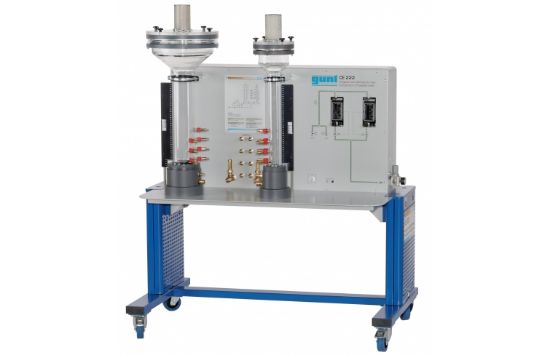Bulk layers can transition from a fixed bed into a fluidised bed when gases flow through them. The fields of application for fluidised beds include, for example, drying solids, in furnaces and coating particles.
This trainer was developed in cooperation with the University of Greenwich, UK. The CE 222 unit contains two transparent columns with different diameters to form a fluidised bed using compressed air as the gas. A scale on the columns indicates the height of the fixed or fluidised bed. Solenoid valves supply compressed air to the column being studied. One column can be operated at a time. The columns can be removed to allow the fixed bed to be changed. Glass beads in different particle sizes are supplied as the packing.
At the start of the experiments, a fixed bed rests on a sinter plate at the bottom of the column. Compressed air flows upwards through the column and exits at the air filter. If the velocity of the air is lower than the fluidisation velocity, the flow simply passes through the fixed bed. At higher velocities, the fixed bed is loosened to such an extent that the particles are put into a state of suspension. The fixed bed transitions into a fluidised bed. If the velocity is further increased, particles are discharged from the fluidised bed (transportation). The air filter at the head of the column retains these particles.
The volumetric flow rate of the compressed air is measured and controlled using two measuring ranges. Both columns are equipped with measuring points, to which differential pressure sensors can be connected. These record the pressure loss in the fixed and fluidised bed. The measured values are transmitted directly to a PC via USB where they can be displayed using the software included. The trainer is operated using the Gunt software. An external compressed air supply is required for operation.

